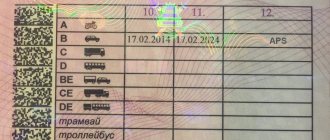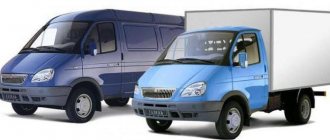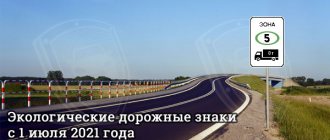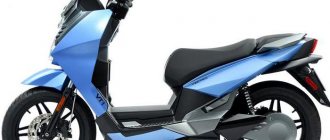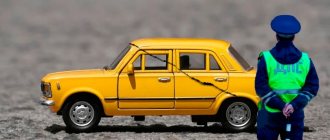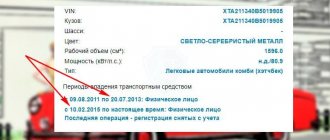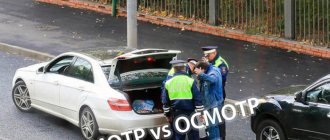Every driver in his car life will not be able to move:
- exclusively on a straight road;
- at one speed;
- without maneuvering.
Most often, you just have to perform various actions - turns, U-turns, reversing and other maneuvers.
All of the above elements are normal and natural conditions of the driver’s activity. Therefore, the Rules provide for a number of special modes of driving or using a vehicle, as well as situations in which the driver must comply with certain traffic rules.
Among the most important modes and situations, the following stand out:
- rebuilding;
- advance;
- overtaking;
- stop;
- parking;
- forced stop;
- let;
- organized transport convoy;
- organized transportation of a group of children.
Let's talk about them in more detail.
Rebuilding
Perhaps the most common type of maneuver performed by a driver is changing lanes. The rules define it this way.
Definition from traffic rules (clause 1.2):
“ Changing lanes ” - leaving an occupied lane or occupied row while maintaining the original direction of movement.
In their driving practice, drivers (especially those living in big cities) cannot drive in only one lane (or in one row). They are forced to change lanes from one lane (row) to another.
The goals of rebuilding can be different.
- for occupying extreme positions before turning, turning;
- to get ahead or overtake;
- to bypass (for example, obstacles);
- for stopping or parking, etc.
At first glance, changing lanes may seem like a simple and elementary maneuver. But in reality this is not the case. It is important to remember that when changing lanes, the driver is most often obliged to give way to vehicles that are already moving in the lane into which he is about to change lanes. And this rule is very often violated, which leads to an accident.
Therefore, the driver’s desire to occupy another lane must be preceded by a clear conviction that the specified lane is free, and by his actions he will not interfere with those vehicles that move along it without changing the direction of their movement.
It is important to remember that violating the rules for changing lanes in heavy traffic is one of the causes of conflicts on the road and, of course, accidents.
Controversial situation
A passenger car and a tractor are driving along a road with a shoulder and two lanes, where there is a continuous marking line, and the latter is moving very slowly. The tractor driver decides to let the car pass.
He turns right and gets as close to the side of the road as possible. The driver of the car is advancing. However, after 400 meters, a traffic police officer stops the car and states that its driver violated the rules, in particular, drove into the oncoming lane. Agree that from such a distance it is simply impossible to objectively assess the situation, but arguing with the inspector is also more expensive.
In this case, you will be given a protocol. It is recommended to write down the number of the vehicle, in our case it is the tractor that you overtook, and even write down its contact details, so that you can later call it to court as a witness.
A similar story can happen not only on the highway, but also in the city. Two cars can easily pass in one lane, and the one driving on the left takes the lead, but does not enter the oncoming lane. The registration of an offense here (even though you, in fact, did not commit it) follows exactly the same scheme as described above.
What is overtaking, advance and detour
If the driver is not satisfied with the speed of the vehicle moving in front of him, then he, as a rule, decides to get ahead of it. The rules regulate this situation too.
Definition from traffic rules (clause 1.2):
“ Advanced ” is the movement of a vehicle at a speed greater than the speed of a passing vehicle.
Overtaking is most often associated with changing lanes or lanes.
Traffic rules know two types of advance:
1) actual advance - without entering the lane (side of the road) for oncoming traffic;
2) overtaking - advance associated with entering the lane (or side of the road) for oncoming traffic.
This issue is fundamental, because violation of the rules of overtaking is severely punished by Russian law - a fine of 5,000 rubles or deprivation of a driver’s license for a period of 4 to 6 months.
Proper classification of overtaking (or lack thereof) will thus help avoid serious trouble with the law. What is “overtaking”, according to traffic regulations? For the driver, this knowledge is a priority.
Definition from traffic rules (clause 1.2):
“ Overtaking ” is an advance of one or more vehicles associated with entering a lane (side of the roadway) intended for oncoming traffic and subsequent return to the previously occupied lane (side of the roadway).
This definition is very capacious, and it requires additional commentary.
Overtaking is a maneuver that is performed exclusively using the oncoming lane - entering it. This is the most important overtaking criterion.
Let us make a few comments to clarify the concept of “overtaking”.
1. The driver should not confuse “pure” advance and overtaking.
Overtaking always involves entering an “oncoming lane”—an oncoming lane or side of the road that is used for oncoming traffic. That is why the driver should associate the concept of “overtaking” with the concept of “oncoming traffic.”
The main rule that will allow the driver to protect his rights against an unscrupulous traffic police officer is: “If there was no oncoming traffic, then this is not overtaking!” And punishment for overtaking will be an illegal action of a traffic police officer.
2. The driver should not confuse overtaking and detour.
The problem here is that the Rules do not personalize or give us the concept of "detour". Therefore, the driver must use common sense and logic when qualifying the concept of "detour".
Overtaking is a maneuver involving getting ahead of moving vehicles. A detour is carried out only in relation to a stationary object (and not necessarily a vehicle).
This is also a fundamental issue, because the penalties for violating the rules of overtaking and the rules of passing (driving into the oncoming lane) differ significantly.
In the work practice of traffic police inspectors, there is still confusion between the concepts of “ahead”, “detour” and “overtaking”. And sometimes such confusion is intentional! And this is abuse of one’s powers, a crime.
Traffic police officers continue to try to fine and punish with deprivation of rights for “overtaking” without going into oncoming traffic, as well as for “overtaking” stationary vehicles. And, by the way, they are very successful! Why? But because the driver cannot protect his rights due to basic ignorance of traffic rules.
So, let's summarize our knowledge.
Overtaking is a maneuver of getting ahead of moving vehicles associated with entering the “oncoming lane” (lane or side of the road).
Advance (“pure”) is a maneuver that is not associated with entering the oncoming lane, but it is performed in relation to vehicles moving in the same direction.
A detour is a maneuver that may involve entering oncoming traffic, but its execution is associated with stationary objects on the road. True, the traffic rules do not say a word about this.
When should you refrain from overtaking?
- If this maneuver is prohibited by traffic rules;
- At the tops of climbs before descents. When driving uphill, you can only overtake if there is sufficient visibility. But when approaching the top of the climb, you need to be prepared for the appearance of a car in the oncoming lane;
- In turns, especially in “closed” ones, since the view of the road is severely limited and an oncoming car may suddenly appear around the turn;
- If the driver of the overtaken vehicle turns on the left turn signal or begins to slow down;
- Following another overtaking car.
What is stopping a vehicle and parking it?
I will try to anticipate the criticism of ill-wishers: stopping and parking of vehicles is not related to movement. On the contrary, these states are associated precisely with the cessation of movement. However, our topic includes consideration of the issue of modes of use of vehicles. Both the stop and the parking lot fit into this theme.
Definition from traffic rules (clause 1.2):
“ Stopping ” is a deliberate cessation of the movement of a vehicle for up to five minutes, and also for longer if this is necessary to board or disembark passengers or load or unload the vehicle.
“ Parking ” is the intentional interruption of the movement of a vehicle for a period of more than 5 minutes for reasons not related to the embarkation or disembarkation of passengers or the loading or unloading of the vehicle.
Analysis of the concepts “stop” and “parking” allows us to immediately determine their relatedness. Both stopping and parking involve the “intentional stopping of movement” of the vehicle. That is, both modes are a consequence of the driver’s volitional decision to stop moving and go into a state of rest.
In other words, there is no force majeure forcing the driver to stop moving! This is the decision of the car enthusiast himself or the result of a request from a passenger. And the last one is a very common occurrence.
What is the difference between “stop” and “parking”? The concepts themselves already point to this main difference - the duration of the vehicle's resting state. Stopping is something short-term, and parking is more fundamental, longer. Indeed, this is the main criterion for distinguishing between a stop and a parking lot.
If the vehicle is stationary for no more than 5 minutes, then it stops. Consequently, regardless of the driver’s wishes, after the planned stop of movement, his vehicle initially makes a stop.
If the car is stationary for more than 5 minutes, then it automatically begins to park. In other words, you cannot park without first being in stop mode for 5 minutes.
However, in addition to the time characteristics (criterion), stopping and parking also differ in the actions of the driver that took place after the movement stopped. If the driver is boarding/disembarking passengers or loading/unloading cargo, he always makes a stop. Regardless of the time of such actions, this is a stop.
Even if boarding/disembarking, loading/unloading takes more than 5 minutes, or 10, or an hour, or a day, it will still be considered a stop.
Parking will be considered a state of rest of the vehicle for a time exceeding 5 minutes, not related to the specified procedures.
And one moment. Stopping at a prohibiting traffic light signal, the corresponding gesture of the traffic controller, to allow a priority pedestrian to pass, to comply with the request of a traffic police officer to stop the vehicle - these are procedures that do not relate to the concepts of “stop” and “parking”.
There was no specific concept for these phenomena in the traffic rules. The driver must understand that, according to traffic regulations, he continues to be in driving mode, but is forced to “pause” for a while in accordance with the Rules.
Reader Questions
- “Is advance on the right prohibited or not?” According to the new traffic rules, passing on the right is allowed.
- “On which side is overtaking a vehicle allowed?” — Answer: According to traffic rules: overtaking a trackless vehicle is allowed only on the left side;
- “Is overtaking on the right allowed or prohibited?” — Answer: According to the traffic rules and the definition of overtaking and ahead of vehicles, when performing the so-called overtaking, you are actually ahead of the vehicle, and ahead of the right is allowed. Special cases of this issue:
- Overtaking on the right, like overtaking on the side of the road, is prohibited by traffic regulations.
- Overtaking on the right, as an obstacle to overtaking (example: vehicle No. 1 which is being overtaken in the oncoming lane, vehicle No. 2 must complete the overtaking, and vehicle No. must not interfere with the maneuver) is prohibited by traffic rules.
- Overtaking on the right, as changing lanes to the right, where it is a section of the road along which vehicles are moving in your direction and getting ahead of the car, is allowed.
“Is advance on the right prohibited or not?”
According to the new traffic rules, overtaking on the right is allowed. On July 12, 2021, new rules for overtaking a vehicle came into effect. When driving on a two-way road, it is prohibited to continue driving in the oncoming lane if the traffic lanes are separated by markings 1.1, 1.3 and 1.11 (the broken line is located on the left), tram tracks, or a dividing strip.
On the road it looks like this. If a vehicle overtakes a second vehicle, entering the lane of oncoming traffic (the maneuver is permitted), where the lanes are separated by a broken line, but does not have time to return to its lane (complete the overtaking maneuver), as a result of which the markings 1.1, 1.3, 1.11 are already on the right of the vehicle, tram tracks or dividing strip - in this case the driver will be at fault, with the possibility of deprivation of his driving license.
It is often necessary not only for beginners, but also for more experienced drivers to distinguish between the definitions of overtaking and ahead. Especially if they are not used to using multi-lane roads. Misunderstanding or confusion of concepts leads to the creation of a large number of accidents caused precisely by an attempt to overtake.
Forced stop
Stopping a vehicle is not always planned (or, as the Rules call it, intentional). It also happens that the driver did not intend to stop of his own free will, but had to! Most often this happens due to some technical malfunction.
And in this case, the traffic rules call this condition a forced stop.
Definition from traffic rules (clause 1.2):
“ Forced stop ” is the cessation of movement of a vehicle due to its technical malfunction or danger created by the cargo being transported, the condition of the driver (passenger) or the appearance of an obstacle on the road.
A forced stop also applies to those vehicles that continue to move. And therefore - in order to achieve maximum safety - in cases of a forced stop in places where stopping and parking are prohibited, the driver is obliged to turn on the hazard warning lights and display an emergency stop sign.
Traffic regulations clearly regulate three cases of forced stop. But they are all similar in their undesirability, unintentionality, unplannedness, because they are exclusively random in nature.
1. Technical malfunction.
An unpleasant prospect for the driver, but a very common occurrence.
2. Obstacle to movement.
For example, there was an accident ahead – in the direction of travel. And this is a danger.
Or avalanches, mudflows, falling stones.
3. Condition of the driver or passenger.
My heart sank, my eyes suddenly watered, I got a sharp headache, the headlights of oncoming cars blinded me...
Are there many cases when the condition of the driver or his passengers will force them to refuse to continue the planned trip, because it makes it unsafe?
4. Danger created by the transported cargo.
Loose cargo on the roof rack is a very common reason for its unauthorized appearance on the roadway or on other vehicles.
If problems are detected with securing the load, you should immediately switch to forced stop mode.
What to do when overtaking is used against you
The main thing is not to interfere with this person, since you are in the same danger as he is. It is worth remembering that in the event of an unforeseen situation, he will perform an evasive maneuver to the right, that is, towards you. There is no need to pick up speed after the overtaking person - this will complicate the procedure, and there is no need for this action, since you are not racing.
Ideally, you should do the opposite and slow down a little. If you notice that the road ahead is uneven and you shouldn’t overtake, signal this to the cars behind you with your left turn signal. With such an action you will ensure not only their safety, but first and foremost your own.
Let
During their movement, each driver is forced to encounter various obstacles along the way. And for a long time (since distant Soviet times), car enthusiasts qualified this concept in their own way and in their own way. Previously, the term “obstacle” was most often used to justify avoiding an object that creates interference. Since 2010, the Russian Federation Traffic Regulations have outlined this concept on legal grounds.
Definition from traffic rules (clause 1.2):
“ Obstacle ” is a stationary object in the traffic lane (faulty or damaged vehicle, roadway defect, foreign objects, etc.) that does not allow further movement along this lane.
A traffic jam or a vehicle stopped in this lane in accordance with the requirements of the Rules is not an obstacle.
Everything is not as simple as it might seem at first glance. Let us analyze the highest priority components of the concept “Obstacle”.
1. An obstacle is a stationary object.
A herd of cows, a flock of sheep, etc. cannot be considered an obstacle because they are capable of moving and moving.
2. An obstacle is considered to be a disabled or damaged vehicle that is unable to move further.
3. A defect in the roadway is also an obstacle, but only if it does not allow you to continue driving in the same lane (or in the same row).
Agree, it’s an incomprehensible situation. That is, what size should a hole be in order to be considered an obstacle?
4. A foreign object is the same obstacle, but again under the condition that further movement is impossible.
And again: what size should a foreign object be so that it does not allow you to move further as normal?
The fundamental importance of the obstacle lies mainly in the priority of movement on the descent and ascent sections, if oncoming traffic is difficult precisely because of this very obstacle.
In areas marked with "Steep Downhill" and "Steep Uphill" warning signs, the driver going downhill must give way, and the driver going uphill has priority. It is in this situation that the correct qualification of the concept “Obstacle” is important.
However, it should be noted that so far not all is well and smooth with the concept of “Obstacle”. Both in traffic rules and in real practice. Both the concept itself and some provisions of the traffic rules require mutual synchronization and joint refinement.
For example, a faulty vehicle made it impossible to move along the lane. But the marking line on a two-lane road is solid, and you cannot cross it. Even when going around an obstacle.
In such conditions, you should call a traffic police officer so that he allows you to cross the continuous road with a wave of his hand. Wouldn’t it be advisable to “finish off” the text of the traffic rules with permission for such a crossing of markings in these conditions without contacting the IDPS and subsequent long wait for its arrival?
And one last thing. Congestion – according to the Rules – is not considered an obstacle.
Just as a vehicle stopped in a traffic lane is not considered an obstacle according to the Rules. For example, to let a pedestrian pass.
What an obstacle this is!
How to behave on the road
Every driver is obliged not only to get ahead correctly, but also to overtake.
For the latter, the key to safe compliance with all traffic rules will be the careful and methodical implementation of all stages. Each driver is obliged not only to correctly advance, but also to overtake. For the latter, the key to safe compliance with all traffic rules will be careful and methodical implementation of all stages. Increased attention is paid to the maneuver because one of its points is crossing the oncoming lane.
This, in turn, requires sufficient concentration of attention from the driver performing such an action. The need for overtaking arises quite often, since in some episodes you simply cannot do without it. Let's consider how to correctly perform this action step by step:
- After making sure that the oncoming lane is clear, you need to increase your speed by 20-30 kilometers per hour (depending on the situation).
- Then, approaching the car, you need to turn on the left turn indicator and, after looking in the rearview mirror and checking that you are being overtaken, cross the center line.
- Having passed the desired object and being several meters ahead of it, move the turn signal to the right and return to your lane.
- Continue driving and turn off the turn signal.
The important point is that when crossing oncoming traffic, you do not need to stop giving the left indicator; with this action you will show those driving behind that they can freely make a maneuver after you.
If the road ahead contains potholes and other irregularities, or there are foreign objects lying there, you need to return to your original place as soon as possible. But even here it will not be without difficulties: initially assess the situation in the right side view mirror, since a motorcyclist or car may appear there.
Organized transport convoy
A special case on the road is special cars rushing by with “flashing lights”, sirens (or “quacks”). We will talk about their rights and responsibilities later. We will also try to answer the question: “Who and why were they granted such privileges?”
But it also happens: these flying and roaring special vehicles accompany other vehicles (usually executive class).
These are our “fathers of nations” going about their business and they cannot, like mere mortals, stand in traffic jams. We are dealing with an organized transport convoy.
Definition from traffic rules (clause 1.2):
“ Organized transport convoy ” is a group of three or more motorized vehicles following directly one after another along the same lane with headlights constantly on, accompanied by a lead vehicle with special color schemes applied to the outer surfaces and flashing blue and blue lights turned on. red flowers.
A very clear and understandable definition, according to which an organized transport convoy is characterized by the following characteristics.
The first sign.
An organized transport convoy is a group of vehicles consisting of three vehicles, one of which is a special vehicle with a red and blue “flashing light”.
Sign two.
Vehicles in an organized transport convoy must move directly behind each other, in one row (one lane) and without any unreasonable distances between each other.
Sign three.
All vehicles moving in such a convoy must have low-beam headlights on. By the way, this requirement is no longer so relevant, because in the Russian Federation, when driving during daylight hours on any roads, drivers must use external lighting devices (daylight, daytime running lights, fog lights).
In reality, an organized transport convoy may not meet the requirements stated in the Rules. The most common violations of the principles are embodied in the following examples.
1. The number of cars in an organized transport convoy may be less than three.
For example, the mayor of a city or the chairman of a local legislative (representative) body travels in a company car, accompanied by a special vehicle with a flashing light. The result is two cars. Formally, traffic rules are violated in terms of the number of convoys, but in fact, an ordinary driver will not be able to do anything, because this flashing light clearly requires priority to be given to the “beacon” and the vehicle it is accompanying.
2. A special vehicle leading an organized transport convoy has only a blue flashing light.
A very frequent and widespread case is when the lead special transport is not a traffic police car, but a police car in general (only with a blue “flashing light”). The rules of an organized transport convoy are also violated, because it is difficult for an ordinary driver to identify vehicles moving in a convoy that are not special vehicles.
3. A car with a flashing light is not equipped with color schemes.
A non-stationary, portable blue flashing light placed on the roof of a car (sometimes a personal one) turns it into a special vehicle, but it is not equipped with color schemes. And legally it cannot be the lead vehicle in the convoy. The ordinary driver needs to be careful here too, since in this situation it is almost impossible to even qualify the very fact of an organized transport convoy.
It is not in vain that we noted the most frequent violations of the requirements in organizing such a traffic regime. It’s just that in the event of a conflict on the road or even an accident involving an organized transport convoy, it can be almost impossible to prove the case to a simple motorist. The courts, for example, in the overwhelming majority of cases (almost 100%) take the side of the “beacon”. Unfortunately, this is Russian judicial practice.
Therefore, the driver, despite such inconsistencies, is obliged to comply with traffic regulations. The requirements that the Rules impose on ordinary drivers regarding the movement of organized transport convoys relate to giving them priority and prohibiting them from crossing such convoys, taking up space in them, and also overtaking them (with an additional special sound signal turned on).
We will talk in more detail about the actions of drivers in the second section of the traffic rules. Here we postulate the following: attentiveness, precaution, caution - these are the “three pillars” of driver safety when he is on the road in conditions of an organized transport convoy moving along it.
Several recommendations for the driver of an overtaking car
- The driving speed must be at least 15 km/h greater than the speed of the vehicle being overtaken. For example, let’s say you are overtaking: if his speed is 70 km/h, then yours should be 85 km/h. Otherwise, overtaking will be delayed.
- The interval to the overtaken vehicle must be at least 1.5 meters.
- Before overtaking outside a populated area, you must sound the horn at least 5 seconds in advance. before the start of the maneuver.
- At night, it is recommended to warn about overtaking by briefly switching the headlights from low to high. This is done like this:
At night, you are driving, for example, with high beam headlights. You catch up with the car in front and begin to prepare to overtake. Switch your headlights to low beam so as not to blind the person you are overtaking in the mirrors.- Turn on the left turn, warn by flashing the headlights briefly, and begin overtaking. Then all the actions follow the algorithm. As soon as you get ahead of the person you are overtaking, you can turn on your high beams. At this moment, the overtaken car is obliged to switch from long-range to short-range, so as not to blind the overtaking vehicle.
These are simple rules of etiquette on the night road; unfortunately, not everyone follows them. More details about the rules for night driving can be found in the article Driving in the dark and in the memo Rules for night driving .
Organized transportation of a group of children
Carefree childhood should be protected by the state. In road traffic, ensuring the safety of children is an important and priority task. To create safe and comfortable conditions for transporting the younger generation on roads, the Rules provide for special conditions - organized transportation of a group of children.
Definition from traffic rules (clause 1.2):
“ Organized transportation of a group of children ” - transportation on a bus, not related to a route vehicle, of a group of children of 8 or more people, carried out without their legal representatives, except for the case when the legal representative(s) is(are) appointed (and) accompanying person(s) or designated medical professional.
It turns out that such transportation is special, targeted. An excursion, a trip to a summer camp, a trip to the theater, a school bus - these are the most common cases of organized transportation of a group of children.
A similar regime for informing other traffic participants is ensured by installing a special identification sign on the vehicle carrying out the transportation - “Transportation of children.” It is displayed in front and behind the vehicle.
Drivers approaching such a vehicle that is picking up or unloading children are subject to special requirements: they must slow down and, if necessary, stop to let children on the road pass.
